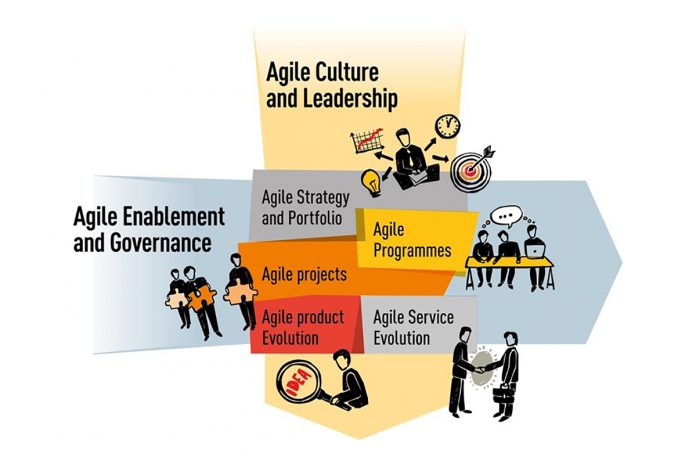The Agile Business Consortium is helping find the most effective solutions by advancing the cause of business agility
In 1994, the DSDM Consortium was formed by a group of blue chip companies who were all struggling to build computer systems that properly met the needs of their sponsoring businesses, in a time and cost effective way. With the Dynamic Systems Development Method, the UK’s first agile approach was born, focused around IT-enabled business change projects.
Why IT-enabled business change?
It is only by evolving business services hand-in-hand with the technology to support them, that the most effective business solution can be achieved. In a business context, software product development alone will often provide limited value.
Why the emphasis on projects?
If all you are building is software, or if the incremental business changes are very small, then the value of running a project is limited, unless dealing with technical or commercial complexities, or issues of scale. It is when significant business change is involved that projects really come into their own – synchronising the complexities of business processes and organisational change, with the technology optimised to support a new or revised business capability.
An evolving business change focus
Over the years, DSDM and the DSDM Consortium have evolved to provide an ever-stronger business change focus. In 2010, in partnership with APMG International, the Consortium launched AgilePM® – DSDM from the project manager’s perspective – providing guidance and certification for a role at the heart of agile change projects. More recently, the DSDM/APMG portfolio has expanded further to embrace Agile Programme Management (AgilePgM®) for business change at scale and Agile Business Analysis (AgileBA®) offering strength and depth in the analytical and modelling disciplines, instrumental to understanding and designing effective business agility solutions.
A bold expansion…
At the end of 2015, driven by the success of recent years both in the UK and internationally, the Consortium began planning a bold expansion aimed at bringing agile values and philosophy to the world of business. Just last month, the Agile Business Consortium was launched along with the first iteration of the new Agile Business Change Framework.
The Agile Business Change Framework
Helping businesses be agile in all business change initiatives – regardless of scale.
Embracing the current suite of DSDM business-change-centric products and signposting expansion into:
Agile Business Strategy – a dynamic new approach for ensuring that business strategy always remains aligned with business and market imperatives
Agile Portfolio Management – ensuring change initiatives are properly aligned with the over-arching, whole-business strategy and remain so throughout their life
Agile Culture and Leadership – providing advice and guidance on leading agile change from whatever your position in the organisation. From C-suite executives and senior business and IT management roles (sponsoring and owning their business change initiatives), through Programme and Project Management roles (organising and coordinating the initiatives), to the leaders in teams who make the change happen, effective agile leadership is key to success
Agile Enablement and Governance – recasting PMO services away from their traditional heartland of process compliance and standardisation, centred around bureaucracy, to embrace a philosophy of enablement and governance centred around people
Agile Service Evolution – focusing on developing business services (with or without IT enablement) exploiting an agile, iterative, collaborative, customer-centric approach that has proved so effective in the software product development space
Becoming more agile (see chart above)
Each of the above value statements embrace potentially conflicting positions and every organisation interested in becoming more agile will need to find a balance point appropriate to their needs, constraints and agile ambition. Each value statement should be considered as a continuum rather than a choice.
At the Agile Business Consortium, we believe that optimal business agility will be achieved through valuing the position on the left of each value statement and that this should be the default focus of any agile organisation. At the same time, we recognise that the position expressed on the right has value and for any businesses must be accommodated but without it becoming dominant.
Your journey to optimal business agility
Regardless of your starting point, the Agile Business Consortium, through its growing network of Accredited Implementation Partners, can help you on your journey to becoming a more agile enterprise. Helping you move from where you are now to the balance point appropriate for your organisation between:
- The declining relevance of the status quo and a world of innovation for business advantage
- Old-school conservative management and inspiring leadership of your greatest assets, your people
- An environment of human machines under hierarchical control and one that exploits the collaborative autonomy of your creative teams
- A conservative culture of individual or organisational self-interest and an unrelenting, immediate customer focus for all you do
AgilePM®, AgilePgM® and AgileBA® are registered trademarks of Agile Business Consortium Limited
Jenny Bailey
Marketing Executive
Agile Business Consortium
Tel: 01233 611 162
Please note: this is a commercial profile












